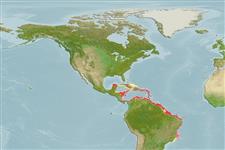Environment: milieu / climate zone / distribuzione batimetrica / distribution range
Ecologia
marino; salmastro benthopelagico; oceanodromo (Ref. 51243); distribuzione batimetrica 0 - 50 m (Ref. 189). Tropical; 23°N - 25°S, 90°W - 32°W (Ref. 189)
Western Atlantic: in the Antilles, from Cuba and perhaps throughout; Guatemala south and east to Venezuela and Trinidad, south to just north of Rio de Janeiro, Brazil).
Size / Peso / Age
Maturità: Lm ? range ? - ? cm
Max length : 30.0 cm TL maschio/sesso non determinato; (Ref. 37032); common length : 17.0 cm TL maschio/sesso non determinato; (Ref. 5217)
Spine dorsali (totale) : 0; Spine anali: 0; Raggi anali molli: 25 - 32. Snout short and pointed, tip at about eye center; maxilla moderate, tip pointed and reaching onto pre-operculum (but not beyond), extending beyond second supra-maxilla; sub-operculum with angular hind margin, but not formed into a triangular projection; lower gill rakers increasing in large fishes. Anal fin origin below front few dorsal fin rays. Silver stripe disappearing with age (Ref. 189).
Body shape (shape guide): fusiform / normal; Cross section: oval.
Found inshore forming quite large schools and also in estuaries, mangroves and other lagoons, penetrating into almost freshwater (salinities of 4.9-32.25 ppt in Santa Cruz Canal, Pernambuco, Brazil). Feeds by filtering plankton. No data on spawning.
Life cycle and mating behavior
Maturità | Riproduzione | Deposizione | Uova | Fecundity | Larve
Spawn in school (Ref. 205).
Whitehead, P.J.P., G.J. Nelson and T. Wongratana, 1988. FAO Species Catalogue. Vol. 7. Clupeoid fishes of the world (Suborder Clupeoidei). An annotated and illustrated catalogue of the herrings, sardines, pilchards, sprats, shads, anchovies and wolf-herrings. FAO Fish. Synop. 125(7/2):305-579. Rome: FAO. (Ref. 189)
IUCN Red List Status (Ref. 130435: Version 2024-2)
Threat to humans
Harmless
Human uses
Pesca: scarso interesse commerciale; esca: usually
Strumenti
Special reports
Download XML
Fonti Internet
Estimates based on models
Preferred temperature (Fonte Biblio.
123201): 26.4 - 28.1, mean 27.5 °C (based on 172 cells).
Phylogenetic diversity index (Fonte Biblio.
82804): PD
50 = 0.5625 [Uniqueness, from 0.5 = low to 2.0 = high].
Bayesian length-weight: a=0.00513 (0.00408 - 0.00645), b=3.17 (3.10 - 3.24), in cm total length, based on LWR estimates for this species (Ref.
93245).
Trophic level (Fonte Biblio.
69278): 3.4 ±0.45 se; based on food items.
Resilienza (Fonte Biblio.
120179): Alto, tempo minimo di raddoppiamento della popolazione meno di 15 mesi (Preliminary K or Fecundity.).
Fishing Vulnerability (Ref.
59153): Low vulnerability (20 of 100).
🛈
Nutrients (Ref.
124155): Calcium = 127 [64, 285] mg/100g; Iron = 1.09 [0.58, 2.01] mg/100g; Protein = 18.1 [16.6, 19.7] %; Omega3 = 0.405 [0.204, 0.884] g/100g; Selenium = 53.2 [27.5, 113.0] μg/100g; VitaminA = 34.3 [8.5, 97.2] μg/100g; Zinc = 1.5 [1.0, 2.2] mg/100g (wet weight);
